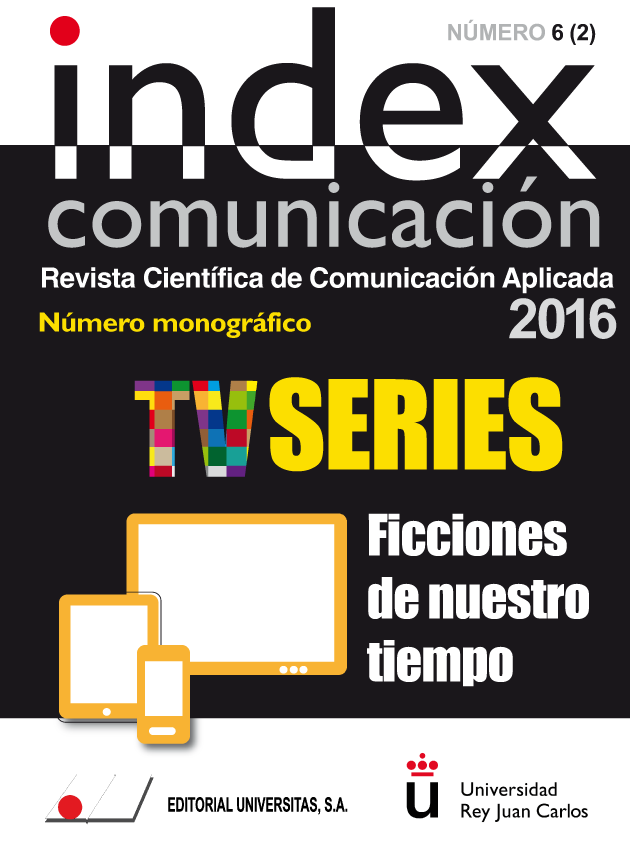'El Ministerio del Tiempo’, tha Introduction of New Concepts in the Spanish TV Series
Keywords:
El Ministerio del Tiempo, TV Series, Fantasy, Science Fiction.Abstract
El Ministerio del Tiempo (TVE, 2015-) has brought freshness to the Spanish television fiction introducing successfully such a stranger concept to the public as time travel. It is a bold proposal, because Spanish TV series rarely have innovative topics. They are usually framed within mystery, adventure, comedy and, in the last years, historic series. This may allow Fantasy and Science Fiction genre –settled in other countries with series like Black Mirror (Channel 4, 2011-) or Battlestar Galactica (SyFy, 2004-2009)– to become as important as other genres. The main objective is to know the reasons why El Ministerio del Tiempo has succeeded with such an innovative proposal. To do so, the keys of other successful series have been analyzed with the objective of knowing what audience likes. In this case, given their variety of topics, filming and target, Cuéntame cómo pasó (TVE, 2001-), Águila Roja (TVE, 2009-) y La que se Avecina (Telecinco, 2007-) have been selected. Subsequently, El Ministerio del Tiempo has been analyzed and compared to them. Data show El Ministerio del Tiempo key is his transversatility of topics, because his main distinctive point, time travel, joins the best features of each genre. Taking from the mystery, his capacity of ask questions; from the adventure, his dynamism; the use of the comedy as a relief point in the plot; and from the historic series his empathy with the audience.Metrics
References
Castillo, J. M. (2009): Televisión, realización y lenguaje audiovisual. Madrid: Instituto RTVE.
Diego, P. (2010): La ficción de la pequeña pantalla. Cincuenta años de series en España. Pamplona: Eunsa.
Gómez Martínez, P. y García García, F. (2010): El guion en las series televisivas: formatos de ficción y presentación de proyectos, 2ª ed. Madrid: Editorial Fragua.
Huerta Floriano, M. Á. y Sangro Colón, P. (2007): De Los Serrano a Cuéntame, cómo se crean las series de televisión en España. Madrid: Arkadin Ediciones.
Igartua Perosanz, J. J. (2007): Persuasión narrativa: el papel de la identificación con los personajes a través de las culturas. Alicante: Editorial Club Universitario
Puebla Martínez, B.; Carrillo Pascual, E. e Íñigo Jurado, A. I. (2012) (coords. y eds.): Ficcionando. Series de televisión a la española. Madrid: Fragua.
Vorhaus, J. (2005): Cómo orquestar una comedia: Los recuersos mas serios para crear los gags, monólogos y narraciones cómicas más desternillantes. Barcelona: Alba Editorial.
Downloads
Published
How to Cite
Issue
Section
License
Authors who submit to this journal agree to the following terms:
Authors retain copyright and ensure the magazine's right to be the first publication of the work as licensed under a Creative Commons Attribution-NoComercial 4.0 International License that allows others to share the work with an acknowledgment of authorship of the work and the initial publication in this magazine, with no commercial purpose.
Authors can establish separate additional agreements for non-exclusive distribution of the version of the work published in the magazine (for example, to an institutional repository or publish it in a book), with an acknowledgment of its initial publication in this journal.
It allows and authors are encouraged to disseminate their work electronically (eg, in institutional repositories or on their own website) prior to and during the submission process, as it can lead to productive exchanges, as well as a citation more early and most of the published work (See The Effect of Open Access).















